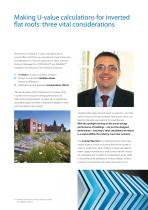 Website:
Dow France
Website:
Dow France
Group: Dow Chemical Company
Catalog excerpts

Building Solutions Making U-value calculations for inverted flat roofs: three vital considerations By Dr Steve Johnson, Technical Manager
Open the catalog to page 1
Making U-value calculations for inverted flat roofs: three vital considerations Reviewing or making a U-value calculation for an inverted flat roof? Then you should bear these three vital considerations in mind according to Dr Steve Johnson, Technical Manager for STYROFOAM™ and XENERGY™ insulation manufacturer, Dow Building Solutions: 1. U-values: Location, Location, Location. 2. Design and declared lambda values: know the difference. 3. Roof build up and potential condensation effects. “We are all aware of the importance of U-values when it comes to the long term energy performance of...
Open the catalog to page 2
U-values: Location, Location, Location. Most people understand that two identical buildings, with identical U-values, would not deliver equal energy efficiency performance if built in different locations, due to differences in local climates. But you wouldn’t expect this to affect a U-value calculation itself - or would you? For an edge-profiled, interlocking board, a substantial proportion of rainwater can be expected to flow beneath the boards: European Technical Approval Guideline (ETAG) 031-1 stipulates that 75% can be assumed for calculation purposes. Inverted flat roof construction is...
Open the catalog to page 3
Design and declared lambda values: know the difference When calculating U-values, we need to assess the individual materials which make up the construction element and know their respective thermal resistances, which can be derived from their thermal conductivity and thickness. If proprietary materials are used, a manufacturer should be able to provide relevant and - more importantly - accurate information for the calculation. In other circumstances, it may be acceptable to use generic information for the materials. Whatever the approach, there must be no confusion about the thermal...
Open the catalog to page 4
Roof build up and potential condensation effects The possibility of interstitial condensation on an inverted flat roof is further diminished, as the waterproofing layer is on the warm side of the insulation boards and thereby acts as an efficient vapour control layer. Surface condensation will also present a low risk, as the insulation boards maintain the roof’s waterproofing close to the building’s internal temperature. Nevertheless, while condensation risks are low, they are not zero, and we need to consider what other physical mechanisms may contribute. As already outlined, rainwater is...
Open the catalog to page 5
Recommendations STYROFOAM™ products include FLOORMATE™, ROOFMATE™ and PERIMATE™. XENERGY™ insulation is also available. STYROFOAM™ and XENERGY™ products contain a flame retardant additive to inhibit accidental ignition from a small fire source. STYROFOAM™ and XENERGY™ are however, combustible and if exposed to an intensive fire may burn rapidly. During shipment, storage, installation and use STYROFOAM™ and XENERGY™ products should not be exposed to flames or other ignition sources. Fire classification is based on small scale tests, which may not reflect the reaction of the products in its...
Open the catalog to page 6All Dow France catalogs and technical brochures
-
Product range
2 Pages
-
INSTA-STIKTMMP
6 Pages
-
GREAT STUFF? PRO
2 Pages














